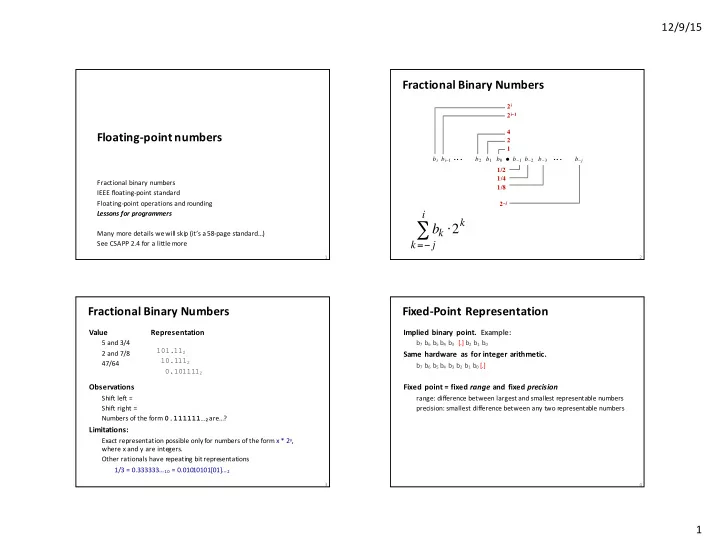

12/9/15 Fractional ¡Binary ¡Numbers 2 i 2 i –1 Floating-‑point ¡numbers 4 2 . 1 b i b i –1 b 2 b 1 b 0 b –1 b –2 b –3 b – j • • • • • • 1/2 1/4 Fractional ¡binary ¡numbers 1/8 IEEE ¡floating-‑point ¡standard Floating-‑point ¡operations ¡and ¡rounding 2 – j Lessons ¡for ¡programmers i b k ⋅ 2 k ∑ Many ¡more ¡details ¡we ¡will ¡skip ¡(it’s ¡a ¡58-‑page ¡standard…) See ¡CSAPP ¡2.4 ¡for ¡a ¡little ¡more k = − j 1 2 Fractional ¡Binary ¡Numbers Fixed-‑Point ¡Representation Value Representation Implied ¡binary ¡ point. Example: 5 ¡and ¡3/4 b 7 b 6 b 5 ¡ b 4 b 3 [.] b 2 b 1 b 0 101.11 2 2 ¡and ¡7/8 Same ¡hardware ¡ as ¡for ¡integer ¡arithmetic. 10.111 2 47/64 b 7 b 6 b 5 ¡ b 4 b 3 b 2 b 1 b 0 [.] 0.101111 2 Observations Fixed ¡point ¡= ¡fixed ¡ range and ¡fixed ¡ precision Shift ¡left ¡= ¡ range: ¡difference ¡between ¡largest ¡and ¡smallest ¡representable ¡numbers Shift ¡right ¡= ¡ precision: ¡smallest ¡difference ¡between ¡any ¡two ¡representable ¡numbers Numbers ¡of ¡the ¡form ¡ 0.111111… 2 are…? Limitations: Exact ¡representation ¡possible ¡only ¡for ¡numbers ¡of ¡the ¡form ¡x ¡* ¡2 y , where ¡x ¡and ¡y ¡are ¡integers. Other ¡rationals have ¡repeating ¡bit ¡representations 1/3 ¡= ¡0.333333… 10 = ¡0.01010101[01]… 2 3 4 1
12/9/15 IEEE ¡Floating ¡Point Floating ¡Point ¡Representation Analogous ¡ to ¡scientific ¡notation Numerical ¡ form: ¡ V 10 = ¡(–1)s * ¡M * ¡2E 12 ¡000 ¡000 1.2 ¡x ¡10 7 1.2e7 0.000 ¡001 ¡2 1.2 ¡x ¡10 -‑6 1.2e-‑6 Sign ¡bit ¡ s determines ¡whether ¡number ¡is ¡negative ¡or ¡positive Significand (mantissa) ¡ M normally ¡a ¡fractional ¡value ¡in ¡range ¡[1.0,2.0) IEEE ¡ Standard ¡ 754 ¡used ¡by ¡all ¡major ¡ CPUs ¡today Exponent ¡ E weights ¡value ¡by ¡a ¡(possibly ¡negative) ¡power ¡of ¡two IEEE ¡= ¡Institute ¡of ¡Electrical ¡and ¡Electronics ¡Engineers Representation: Driven ¡by ¡numerical ¡ concerns MSB ¡ s = ¡sign ¡bit ¡ s Rounding, ¡overflow, ¡underflow exp field ¡encodes ¡ E ¡ (but ¡is ¡ not ¡equal ¡ to ¡E) Numerically ¡well-‑behaved, ¡but ¡hard ¡to ¡make ¡fast ¡in ¡hardware frac field ¡encodes ¡ M ¡ (but ¡is ¡ not ¡equal ¡ to ¡M) s exp frac 5 6 Precisions Normalization ¡and ¡Special ¡Values Single ¡precision ¡ (float) : ¡ 32 ¡bits V ¡= ¡(–1)s * ¡M * ¡2E s exp frac “Normalized” ¡ = ¡M has ¡the ¡form ¡1.xxxxx s exp frac As ¡in ¡scientific ¡notation 1 ¡bit 8 ¡bits 23 ¡bits 0.011 ¡x ¡2 5 = ¡1.1 ¡x ¡2 3 , ¡latter ¡is ¡more ¡compact Double ¡precision ¡ (double) : ¡ 64 ¡bits Do ¡not ¡store ¡the ¡(guaranteed) ¡leading ¡1. Special ¡values: (How ¡do ¡we ¡represent ¡0.0? ¡ ¡1.0/0.0?) s exp frac zero: s == ¡0 exp == ¡00...0 frac == ¡00...0 1 ¡bit 11 ¡bits 52 ¡bits +inf, ¡-‑inf : exp == ¡11...1 frac == ¡00...0 1.0/0.0 ¡= ¡ − 1.0/ − 0.0 ¡= ¡+inf, ¡ ¡1.0/ − 0.0 ¡= ¡ − 1.0/0.0 ¡= ¡-‑inf Finite ¡representation ¡ of ¡infinite ¡range: NaN (“Not ¡a ¡Number”): exp == ¡11...1 ¡ ¡ ¡ ¡ ¡ frac != ¡00...0 Not ¡all ¡values ¡can ¡be ¡represented ¡exactly. ¡ sqrt(-‑1), ¡ ∞ − ∞ , ∞ ∗ 0 , ¡etc. Some ¡are ¡approximated. Denormalized/subnormal ¡ values ¡ (near ¡0.0) ¡not ¡covered ¡here. 7 8 2
12/9/15 Floating ¡Point ¡Arithmetic Lessons ¡for ¡programmers V ¡= ¡(–1)s * ¡M * ¡2E V ¡= ¡(–1) s * ¡M * ¡2 E s exp frac s exp frac double x = ..., y = ...; float ≠ ¡real ¡number ¡≠ ¡ double Rounding ¡breaks ¡associativity and ¡other ¡properties. double z = x + y; 1. Compute ¡exact ¡result. double a = ..., b = ...; 2. Round , ¡to ¡fit: ... Overflow ¡ exponent ¡if ¡it ¡is ¡too ¡wide ¡for ¡ exp . if (a == b) ... Drop ¡LSBs ¡of ¡significand if ¡it ¡is ¡too ¡wide ¡for ¡ frac . Underflow ¡if ¡nearest ¡ representable ¡ value ¡is ¡0. if (abs(a - b) < epsilon) ... … More ¡shortly… 9 10 3
Recommend
More recommend